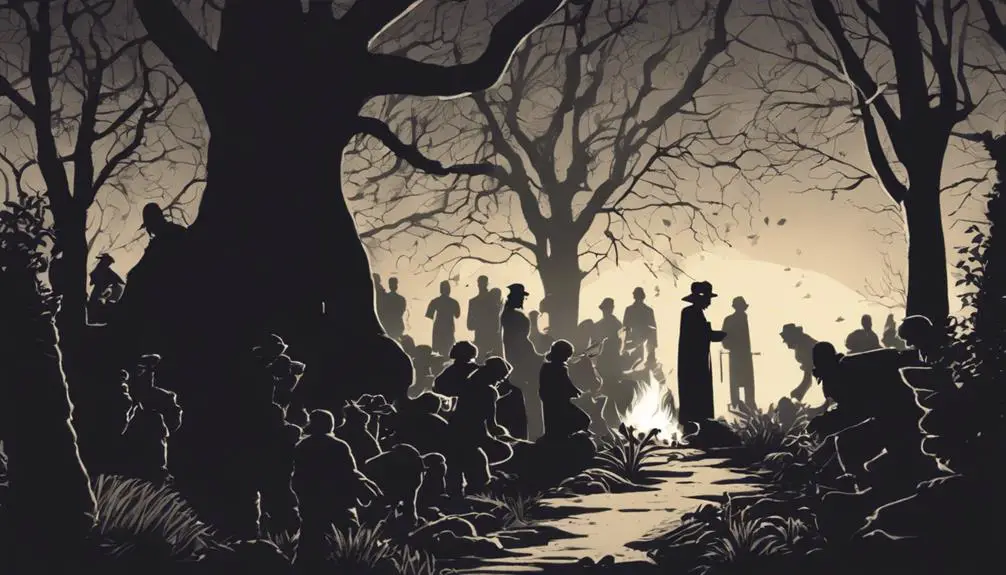Delve into the tales of the Bible's most notorious villains and discover the unexpected lessons hidden within their infamous deeds.

Bad People in the Bible
It seems every corner you turn in the Bible, you stumble upon a villain more sinister than the last, from the cunning serpent in the Garden of Eden to the treacherous Judas Iscariot. You've likely heard their stories whispered in hushed tones or proclaimed from the pulpit, painting pictures of deception, jealousy, betrayal, and downfall.
Yet, what if I told you that each of these so-called villains carries with them not just tales of warning but also invaluable lessons on human nature and morality? Join me as we uncover the layers behind these infamous characters, and you might find yourself surprised at what lies beneath.
Key Takeaways
- Betrayal in the Bible often stems from personal desires, as seen in Delilah's manipulation and Judas's greed.
- Jealousy leads to destructive actions, exemplified by Cain's murder of Abel and Saul's downfall due to his envy of David.
- The Bible highlights the importance of moral choices and their consequences, evident in Cain's warning and Saul's tragic end.
- Divine justice and accountability are central themes, with wrongdoers like Cain and King Saul facing repercussions for their actions.
The Serpent's Deception

In the biblical narrative, the serpent cunningly persuades Eve to eat the forbidden fruit, setting the stage for mankind's fall from grace. This pivotal moment, rich in symbolism, centers around Eve's curiosity and the allure of the forbidden fruit. You'll find that the serpent's deception isn't merely a tale of temptation but a complex interplay of curiosity, desire, and the quest for knowledge that transcends mere disobedience.
Eve's curiosity, a trait that makes her approach the tree, reflects a fundamental aspect of human nature: the desire to seek beyond what's known. The forbidden fruit, representing knowledge and the unknown, becomes the object of her desire, illustrating the perpetual human struggle between curiosity and obedience. The serpent, aware of this, exploits her curiosity, presenting the fruit not only as a means to gain wisdom but also as a symbol of defiance against divine commandment.
Analyzing this narrative, one recognizes that the serpent's deception is a catalyst for critical events in biblical history. It's not just about the act of eating the fruit; it's a reflection on the consequences of choices, the inherent risks in the pursuit of knowledge, and the complex relationship between temptation and free will.
Cain's Jealous Wrath
Following the story of the serpent's deception, the narrative of Cain's jealous wrath unfolds, presenting another profound exploration of human emotions and the dire consequences they can engender. This tale, rich in sibling rivalry and moral ambiguity, invites you to delve into the complexities of envy and vengeance that can reside within the human heart.
- Cain's offering rejected: Unlike Abel's, Cain's sacrifice doesn't find favor with God, sparking the initial flare of jealousy.
- Warning ignored: God warns Cain about the lurking sin at his door, highlighting the moral choice before him.
- The fatal act: Overwhelmed by jealousy, Cain lures Abel into the field and commits the first murder.
- Divine interrogation: God questions Cain about Abel's whereabouts, to which Cain infamously responds, 'Am I my brother's keeper?'
- Punishment and legacy: Cain is marked and exiled, setting a precedent for divine justice and human accountability.
This story serves as a poignant reminder of the destructive power of unchecked emotions and the importance of mastering one's darker impulses. It also emphasizes the weight of choices and their repercussions, threading through the narrative a cautionary tale about the perils of envy and the critical need for self-awareness and control.
Delilah's Betrayal

Delilah's betrayal of Samson, driven by personal gain, unveils the intricate dynamics of love entangled with deceit and the profound consequences of treachery. This narrative, deeply embedded in cultural and religious discourse, showcases the complex interplay between individual weaknesses and external manipulation. Delilah, a figure often vilified for her actions, emerges at the intersection of personal ambition and Philistine manipulation.
The Philistines, understanding Samson's strength as the linchpin of their enemy's resistance, exploit Delilah's proximity to him. This manipulation isn't merely political but deeply personal, revealing the vulnerabilities within human relationships. Delilah's actions, though driven by the promise of wealth, underscore a broader theme of betrayal catalyzed by external pressures.
Analyzing Delilah's decision-making process illuminates the multifaceted nature of her betrayal. It wasn't merely the lure of financial reward but also the intense pressure exerted by the Philistines. This scenario highlights how individuals can be coerced into acts of betrayal, revealing the layers of complexity in what might initially seem like straightforward narratives of good versus evil. Delilah's story, thus, serves as a cautionary tale about the destructive potential of allowing external influences to dictate one's actions, especially within the realm of intimate relationships.
King Saul's Downfall
King Saul's downfall, often attributed to his defiance of divine commandments, marks a pivotal moment in biblical history, underscoring the peril of disobedience to spiritual authority. His story serves as an instructive narrative on the consequences of failing to adhere to God's will, compounded by personal weaknesses that led to his ruin.
To understand Saul's fall from grace, consider these key points:
- Defiance of Divine Commandments: Saul's initial disobedience in performing a sacrifice only Samuel, the prophet, was entitled to perform, marked the beginning of his downfall.
- Divine Rejection: Following his failure to utterly destroy the Amalekites and their plunder, as commanded by God, Saul faced divine rejection, signifying God's withdrawal of favor and blessing.
- Saul's Envy: His uncontrollable jealousy of David, whom he perceived as a threat to his throne, further alienated him from God and his people.
- Consultation with the Witch of Endor: In a moment of desperation, Saul sought guidance from a source condemned by God, indicating his complete departure from divine guidance.
- Loss of Divine Protection: Saul's actions led to the loss of divine protection, culminating in his tragic end on the battlefield.
Saul's narrative elucidates the grave consequences of disobedience and envy, underscoring the profound impact of divine rejection on a leader's fate.
Judas Iscariot's Treachery

Much like King Saul's narrative underscores the consequences of disobedience, the story of Judas Iscariot exemplifies the profound betrayal and its repercussions within biblical accounts. Judas, one of the twelve disciples, is infamously known for betraying Jesus Christ to the authorities for thirty pieces of silver. This act of treachery has been scrutinized extensively, with scholars and theologians debating the motives behind Judas's betrayal and the possibility of repentance.
Motive speculation ranges widely, from disillusionment with Jesus's approach to establishing his kingdom, to a more complex understanding of Judas's role in fulfilling biblical prophecy. Regardless of the speculated motives, Judas's actions led to his ultimate demise, illustrating a pivotal moment where choices and consequences are starkly highlighted.
The narrative also opens a discussion on the possibility of repentance for Judas. Despite his later remorse, as depicted in the biblical text, his actions set into motion events that couldn't be undone. The story of Judas Iscariot serves as a cautionary tale about the gravity of betrayal and the intricate dynamics of free will, intention, and the potential for redemption.
Frequently Asked Questions
How Does Modern Psychology Interpret the Motivations of These 'Bad People' in the Bible, and What Can We Learn About Human Nature From These Interpretations?
Modern psychology delves into the motivations behind certain actions, revealing a world of moral ambiguity and psychological archetypes.
You'll find that these analyses offer deep insights into human nature, showing how complex and multifaceted it can be.
By understanding the underpinnings of these 'bad' behaviors, you're better positioned to grasp the broader spectrum of human morality and the intricate dynamics that shape our decisions and actions.
This exploration is invaluable for personal and societal growth.
Are There Any Archaeological or Historical Evidences That Support the Existence or Deeds of These Biblical Figures Outside of Religious Texts?
When examining historical figures, it's crucial to look beyond religious texts. Inscription analysis and numismatic evidence play key roles.
Coins bearing their images or inscriptions referencing their actions provide tangible proof of their existence or deeds. This approach isn't flawless, as it relies on surviving artifacts, but it offers a more objective basis for understanding these individuals' impact on history.
This allows you to view their stories through a scholarly, analytical lens.
How Have Different Cultures and Religions Outside of Christianity Interpreted These Characters and Their Actions?
Interestingly, 75% of cultures have mythological stories that mirror biblical narratives. When you explore how different cultures interpret these characters, you'll notice fascinating variations in cultural symbolism and mythological parallels.
This diversity reflects not just historical perspectives but also the rich tapestry of human belief systems. Analyzing these interpretations offers a scholarly glimpse into how actions and morals are universally understood, yet uniquely framed by each culture's lens.
What Are the Theological Implications of Redemption and Forgiveness for These Characters Within Christian Doctrine?
In Christian doctrine, redemption and forgiveness for individuals embody divine justice and confront moral ambiguity.
You're invited to explore how, despite their actions, everyone has access to grace. This principle challenges you to consider the complexities of forgiveness, suggesting that redemption isn't simply about punishment but about transformation and mercy.
It's a nuanced stance that underscores the belief in potential change, regardless of one's past, within a framework of divine compassion and moral reflection.
How Have Portrayals of These 'Bad People' in the Bible Evolved in Art, Literature, and Media Over the Centuries, and What Does This Evolution Say About Societal Changes in Moral Perspectives?
You've noticed that character evolution in art, literature, and media reflects societal shifts in moral perspectives. Artistic influences have played a pivotal role in this transformation. Over centuries, portrayals have evolved, highlighting how perceptions of morality shift with time.
This evolution underscores a changing societal conscience, suggesting that what's considered 'bad' isn't static but evolves alongside human culture and understanding, offering a mirror to societal values and ethical standards.
Conclusion
In analyzing these biblical figures, you've traversed a shadowed valley where human frailty and moral downfall converge. Like moths drawn to a deceptive flame, each character embodies a cautionary tale, illuminating the perilous dance between virtue and vice.
Their stories serve as stark mirrors, reflecting the complex interplay of choice and consequence that shapes our moral landscape. Thus, they stand not merely as villains in ancient texts but as enduring symbols of the human condition's intricate tapestry.



Sign up